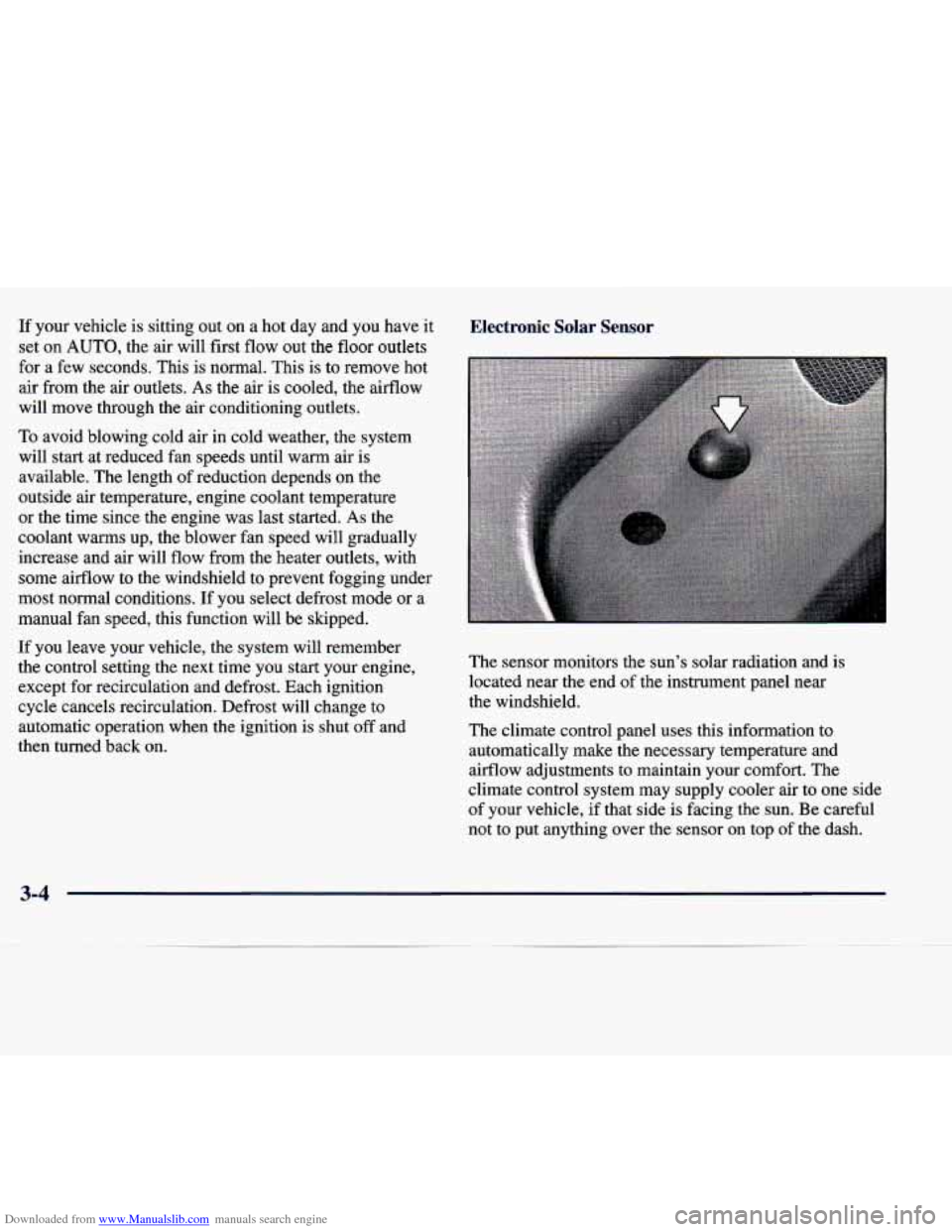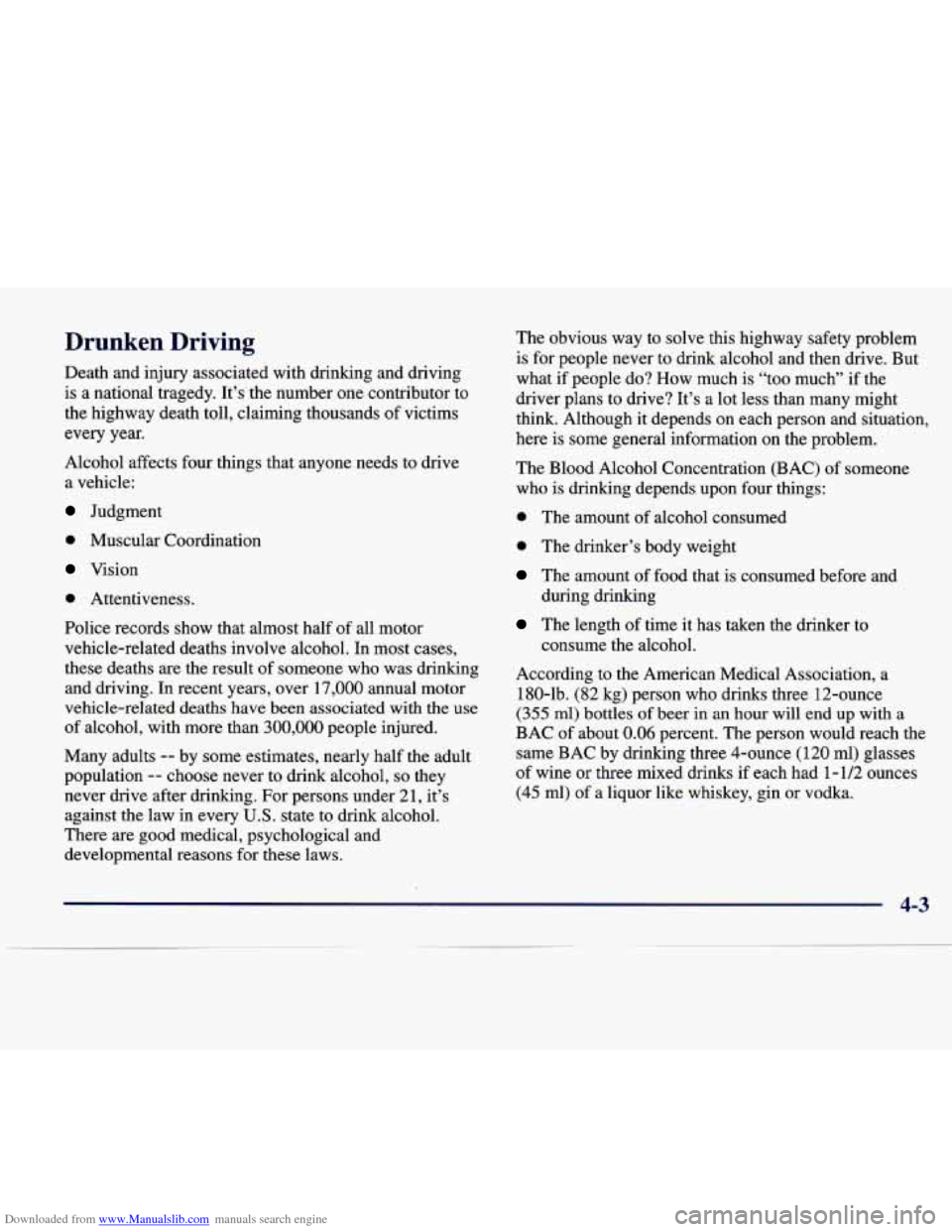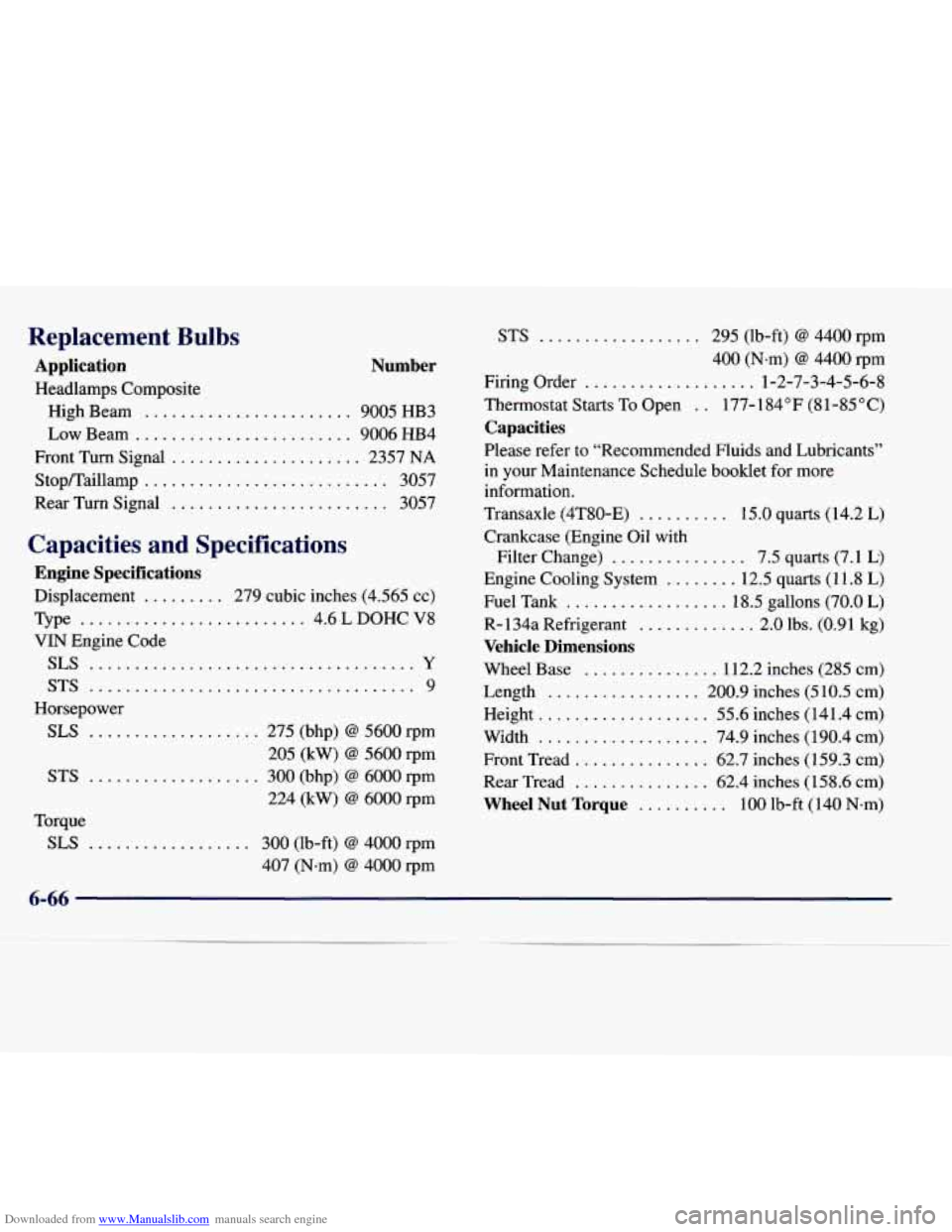Page 155 of 378

Downloaded from www.Manualslib.com manuals search engine If your vehicle is sitting out on a hot day and you have it
set on
AUTO, the air will first flow out the floor outlets
for a few seconds. This is normal. This is to remove hot
air from the air outlets.
As the air is cooled, the airflow
will move through the air conditioning outlets.
To avoid blowing cold air in cold weather, the system
will start at reduced fan speeds until warm air is
available. The length of reduction depends on the
outside air temperature, engine coolant temperature
or the time since the engine was last started.
As the
coolant warms up, the blower fan speed will gradually
increase and air will flow from the heater outlets, with
some airflow to the windshield to prevent fogging under
most normal conditions. If you select defrost mode or a
manual fan speed, this function will be skipped.
If you leave your vehicle, the system will remember
the control setting the next time you start your engine,
except for recirculation and defrost. Each ignition
cycle cancels recirculation. Defrost will change to
automatic operation when the ignition is shut
off and
then turned back on.
Electronic Solar Sensor Electronic Solar Sensor
The sensor monitors the sun’s solar radiation and is
located near the end of the instrument panel near
the windshield.
The climate control panel uses this information to
automatically make
the necessary temperature and
airflow adjustments to maintain your comfort. The
climate control system may supply cooler air to one side
of your vehicle, if that side is facing the sun. Be careful
not to put anything over the sensor on top
of the dash.
3-4
Page 200 of 378

Downloaded from www.Manualslib.com manuals search engine Drunken Driving
Death and injury associated with drinking and driving
is a national tragedy. It’s the number one contributor to
the highway death toll, claiming thousands of victims
every year.
Alcohol affects four things that anyone needs to drive
a vehicle:
Judgment
0 Muscular Coordination
Vision
0 Attentiveness.
Police records show that almost half of all motor
vehicle-related deaths involve alcohol. In most cases,
these deaths are the result of someone who was drinking
and driving. In recent years, over 17,000 annual motor
vehicle-related deaths have been associated with the use
of alcohol, with more than
300,000 people injured.
Many adults
-- by some estimates, nearly half the adult
population
-- choose never to drink alcohol, so they
never drive after drinking. For persons under
21, it’s
against the law in every
U.S. state to drink alcohol.
There are good medical, psychological and
developmental reasons for these laws. The
obvious way to solve this highway safety problem
is for people never to drink alcohol and then drive. But
what if people do? How much is “too much”
if the
driver plans to drive?
It’s a lot less than many might
think. Although it depends on each person and situation,
here is some general information on the problem.
The Blood Alcohol Concentration (BAC) of someone
who is drinking depends upon four things:
0 The amount of alcohol consumed
0 The drinker’s body weight
The amount of food that is consumed before and
during drinking
The length of time it has taken the drinker to
consume the alcohol.
According to the American Medical Association, a 180-lb. (82 kg) person who drinks three 12-ounce
(355 ml) bottles of beer in an hour will end up with a
BAC of about 0.06 percent. The person would reach the
same BAC by drinking three 4-ounce
(120 ml) glasses
of wine or three mixed drinks if each had 1 - 1/2 ounces
(45 ml) of a liquor like whiskey, gin or vodka.
Page 316 of 378
Downloaded from www.Manualslib.com manuals search engine Windshield Wiper Blade -
Replacement
It’s a good idea to clean or replace the wiper blade assembly on a regular basis or when worn. For proper
windshield wiper blade length and type, see “Normal
Maintenance Replacement
Parts” later in this section.
To replace the wiper blade assembly:
1. Lift the wiper up from the windshield and set into
the vertically-locked position.
2. Press the tab that holds the wiper blade to the arm.
3. Slide the blade down and off the arm.
4. Slide in the new blade and snap into place.
Tires
Your new vehicle comes with high-quality tires made by
a leading tire manufacturer.
If you ever have questions
about your tire warranty and where to obtain service, see
your Cadillac Warranty booklet for details.
6-41
Page 341 of 378

Downloaded from www.Manualslib.com manuals search engine Replacement Bulbs
Application Number
Headlamps Composite High Beam
....................... 9005 HB3
Low Beam ........................ 9006 HB4
Front Turn Signal ..................... 2357 NA
Stop/Taillamp ........................... 3057
Rear Turn Signal
........................ 3057
Capacities and Specifications
Engine Specifications
Displacement ......... 279 cubic inches (4.565 cc)
Type
......................... 4.6 L DOHC V8
VIN Engine Code
SLS .................................... Y
STS .................................... 9
Horsepower
SLS ................... 275 (bhp) @ 5600 rpm
STS
................... 300 (bhp) @ 6000 rpm
205 (kW)
@ 5600 rpm
224 (kW)
@ 6000 rpm
Torque
SLS .................. 300 (lb-ft) @ 4000 rpm
407 (N-m)
@ 4000 rpm STS
.................. 295 (lb-ft) 63 4400 rpm
Firing Order
................... 1-2-7-3-4-5-6-8
400
(N-m)
@ 4400 rpm
Thermostat Starts To Open
, , 177- 184°F (8 1-85 “C)
Capacities
Please refer to “Recommended Fluids and Lubricants”
in your Maintenance Schedule booklet for more
information.
Transaxle
(4T80-E) .......... 15.0 quarts (14.2 L)
Crankcase (Engine Oil with Filter Change)
............... 7.5 quarts (7.1 L)
Engine Cooling System ........ 12.5 quarts (1 1.8 L)
R- 134a Refrigerant ............. 2.0 lbs. (0.9 1 kg)
Vehicle Dimensions
Wheel Base ............... 112.2 inches (285 cm)
Length
................. 200.9 inches (510.5 cm)
Height
................... 55.6 inches (141.4 cm)
Width
................... 74.9 inches (190.4 cm)
Front Tread
............... 62.7 inches (1 59.3 cm)
Rear Tread
............... 62.4 inches (158.6 cm)
Wheel Nut Torque .......... 100 lb-ft (140 N-m)
Fuel Tank
.................. 18.5 gallons (70.0 L)
6-66